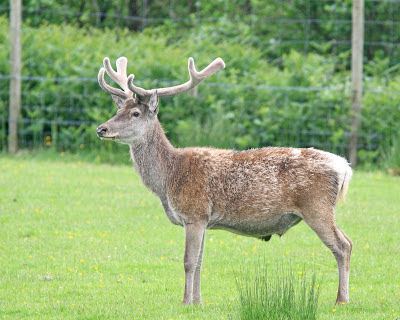A stunning day's weather with warm sunshine and a sometimes lively breeze greeted us on Wednesday this week. Much of the day was spent in the Findhorn Valley and we walked a large chunk of it. Certainly in the past many birders have referred to it as 'The valley of the eagles' and it didn't disappoint on this occasion. There is a variety of habitat squeezed in to this picturesque valley and steep-sided hills and as a consequence there is a large range of common species to be seen. Despite the fabulous weather we hardly saw a soul all day, Scotland really is the place to get away from it all!
Eight species of raptor put on a good show and included two White-tailed Eagles, two Golden Eagles, Red Kite and Osprey. An adult male Peregrine was watched as he was effectively bullied by his two juvenile female offspring in superb aerial displays. Common Tern, Common Sandpiper and Grey Wagtail were noted on the river and the valley bottom held good numbers of Curlew and Oystercatcher, with a couple of pairs of Snipe 'chipping' and 'drumming'. Passerines included Redstart, Tree Pipit, Spotted Flycatcher, Siskin and Lesser Redpoll. We saw a couple of fly-over 'Crossbills' and later came across an injured bird hopping around on the ground (images below), which seems a good candidate for Scottish Crossbill. It had a badly damaged wing and had either collided with something or been struck by a raptor; we felt we couldn't provide a positive outcome by recovering the bird so we decided to leave it where it was (it was bright and perky but clearly there was a problem with one wing and there appears to be superficial injuries to the head too).
The Findhorn Valley always attracts large numbers of Red Deer and despite the commencement of stalking from 1st July, they mostly simply watch as you pass by rather than running for the hills! Good numbers of Brown Hare were in the valley and at least one Mountain Hare too.
Late afternoon saw us at Lochindorb (between Carrbridge and Nairn). The loch held a pair of resplendent Black-throated Divers but sadly no young. Perhaps no surprise when we saw the proximity of fishermen to the only island and appropriate nesting site on the loch! An Osprey flew through and the heather moors in this area are managed for Red Grouse and we saw a couple of these. The moors also supported Curlew and Golden Plover and a juvenile Cuckoo being fed by its Meadow Pipit 'parents', one of the pipits even standing on its back to feed it!
Our final venue for the day was the woodland bordering Grantown on Spey. The wrong time of the year and day to see Capercallie, we gave it a go anyway with the anticipated negative result! Birds noted included Crested Tit, Tree Pipit, Spotted Flycatcher etc.
Regards
E & N
 |
| Female Tufted Duck with ducklings |
 |
| Mountain Hare |
 |
| Brown Hare |
 |
| Scottish Crossbill |
 |
| Red Squirrel |
 |
| Juvenile Cuckoo and Meadow Pipit (Cotton Grass in the way)! |

+2nd+July+022+Red+Squirrel.jpg)
+2nd+July+234+Pine+Marten.jpg)










































